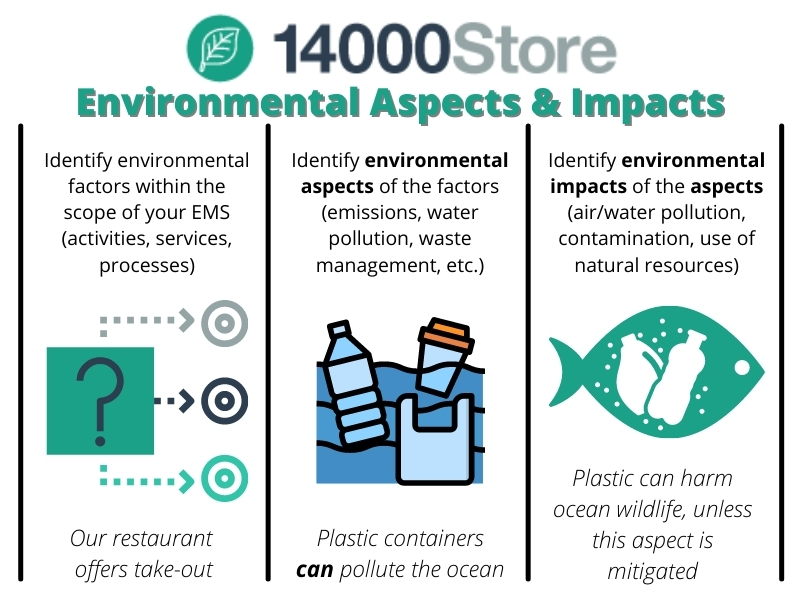What are Environmental Aspects & Impacts?
An environmental aspect is defined in ISO 14001:2015 as an element of an organization’s activities, products or services that may impact, or does impact, the environment. An environmental impact is a result of an environmental aspect.
So, what exactly does this mean? In simpler terms, an environmental aspect is anything that happens within your organization that interacts with the environment, which means it and has a potential environmental impact. This encompasses both negative and positive interactions with the environment. Many people focus on the negative, but it is important to remember that anything that has a positive effect also matters, for example, recycling, or planting trees. All in all, it is important for your organization and your EMS to identify all of the aspects – both negative and positive.

Many organizations find it useful to categorize environmental aspects. ISO 14001 Annex A helps make this a bit easier. There are six categories and this will help you work with the Environmental Self Assessment Tool Areas.
| ISO 14001 Annex A Categories | Organization Environmental ASAT Major Areas |
| Emissions to Air | Air |
| Releases to Water | Water/Wastewater |
| Waste Management | Solid Waste: Hazardous and Industrial |
| Contamination of Land | Land Management |
| Consumption of Natural Resources and Raw Materials | — |
| Other Environmental Issues Particular to your General Locality and Community (noise, odors, etc.) | Location Management |
| * | Chemical Release |
| * | Toxic Substances |
As an organization, you do not have to use this list, or you can subdivide these categories and add other aspects such as noise, employee exposure, etc. If the list seems advantageous for you, then use it, but it is not a requirement if it does not serve you well.
Areas Where Environmental Aspects often Occur
Another great way to classify environmental aspects is to break them down to areas in your organization of where they could arise. Common examples are:
- Within the office
- During Manufacturing Processes
- Transportation
- Boilers or other machinery
Classification of Environmental Aspects
Within the categories, you may also want to categorize the environmental aspect into classifications. Classifications will help allow you to understand and determine what control you have over environmental aspects and prioritize any that may need to be controlled. These categories are:
- Controlled
- Influenced
- Significant
- Nonsignificant
- Positive
Why is it important to identify Environmental Aspects?
The goal for identifying environmental aspects is to understand which are important environmental issues to be managed and controlled by your EMS. Once you have finished identifying all environmental aspects, the next step is to consider if you have the ability to control or influence these activities.
What are the ISO 14001 Requirements in regards to Environmental Aspects?
The standard requires organizations to establish and maintain a procedure for identifying environmental aspects, any activities associated with them including products and services, that are within your control. Once you have identified these aspects you must determine which have a significant impact on the environment. Prioritizing the aspects is important when it comes to continual improvement within your organization.
ISO 14001 also requires that organizations consider lifecycle stages of an organization’s environmental aspects. For example, your organization should ensure that energy efficiency is considered in the purchasing process. In regards to disposal, can you better segregate your waste? Could items be fixed rather than replaced? Environmental management must be considered throughout the entire process.
ISO 14001 and ISO 50001
It is clear that energy and the environment have a clear connection, and therefore it may be beneficial for your organization to become compliant with both ISO 14001 and ISO 50001. Implementing standards together can be greatly beneficial, and is easier than integrating two management systems separately into your organization. If you are interested, you should consider implementing ISO 14001 and ISO 50001 together.


